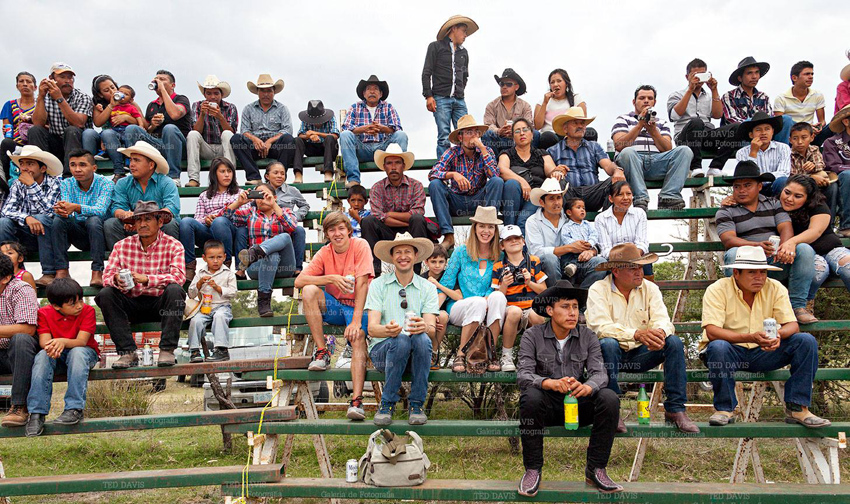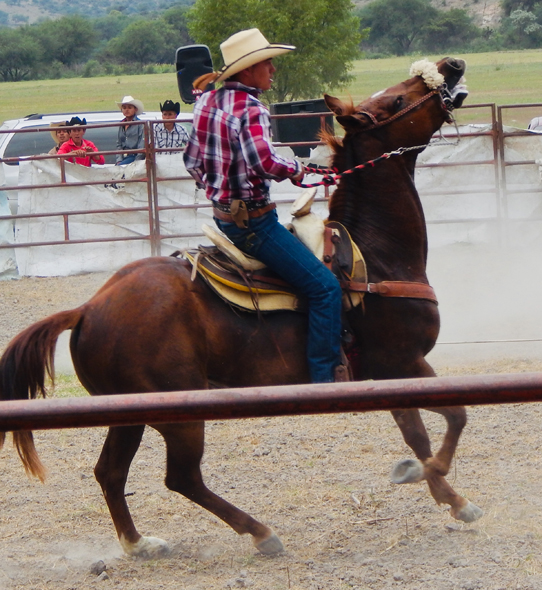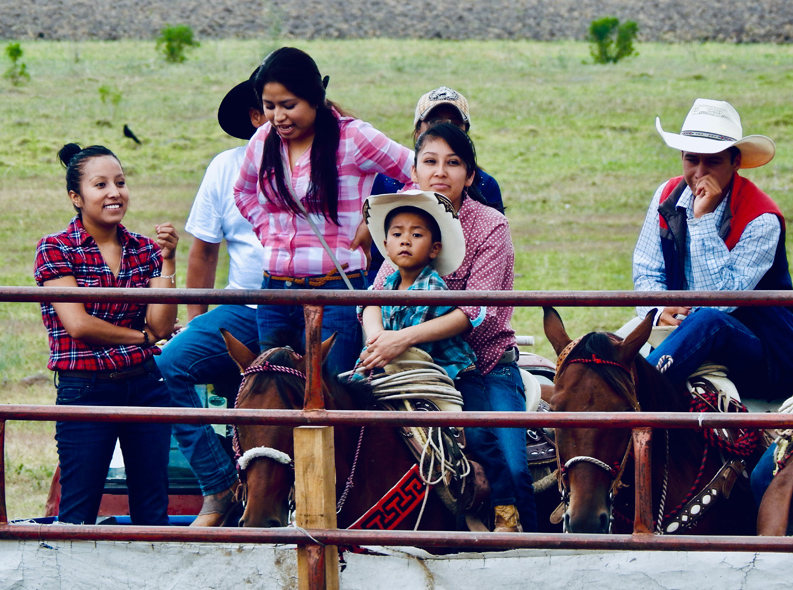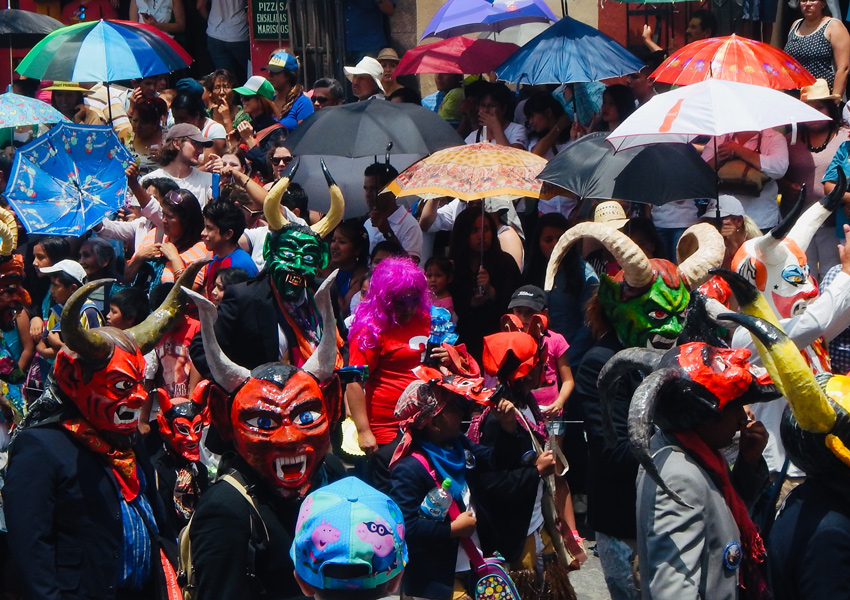|

Photo credit: Ted Davis
by Ann Marie Jackson
"That's so rude!" exclaims my seven-year-old son as the bull's body slams into the ground. The powerful animal lies unnaturally still, stretched taut by one lariat around his horns and another around his hind legs. The other end of each rope is in the hands of an expert cowboy, wound firmly around the pommel of his saddle. Each cowboy sits astride a beautiful horse with practiced ease, looking like perfectly cast extras in a Marlboro commercial from the late eighties. Next to my son, our friend Sam chuckles at his indignation.
"Yes, how rude,” Sam agrees. "But you know, the bull is going to be fine, I promise. I know these cowboys, and these bulls are really like their pets. They don't want to hurt their pets."
"Really?" asks Tristan, clearly unconvinced.
We watch as in one well-choreographed moment, a third lithe cowboy puts himself astride over the bull as the first two release the ropes. The bull is back on his feet in an instant, furious at the way he’s been treated and determined to remove the nuisance now sitting on his back. The cowboy holds on. The animal leaps, twists, kicks and shimmies his way across the corral, emoting anger with every ounce of his muscular body. Tristan’s eyes couldn’t possibly open any wider as he takes in this contest. Only when the cowboy lands in the dirt, and both bull and man walk away unharmed, does the air finally burst from his lungs.
“Ok,” he tells Sam, “I guess that was fair.”

I relax into my seat, reassured that my son is not about to scold the cowboys or launch a boycott. Now I can really take in the scene in front of us, which could have been lifted from a well-produced Hollywood western. A large corral has been constructed in the middle of nowhere. An expanse of pasture in rainy-season green stretches wide, dotted by mesquite trees and nopales. A small, clear river empties into a wide lake behind an unseen dam. Beyond the lake, hills rise in dusky blues and grays, stone outcroppings adding interest to their silhouettes. Cowboys in crisp jeans and button-up shirts await their turn, sitting proudly and patiently on well-groomed horses. Their family and friends find good vantage points from the beds of pickup trucks backed up to the corral, and a brass band in peacock blue and yellow uniforms adds a festive soundtrack. We survey this tableau from our perches on ancient bleachers arranged next to the corral. As the only gringos in attendance, we draw more than a few curious looks.
To me, the most amazing aspect of the event unfolding before us is that it’s taking place on the same afternoon and only a few miles away from our first surreal event of the day. Only a scant half-hour earlier, we’d been in the center of San Miguel de Allende cheering the inimitable spectacle that is El Día de Los Locos. A twenty-five-minute drive took us out of the cobblestone streets of San Miguel’s historic center, over a brief stretch of highway and a winding country road onto a dirt path that couldn’t possibly be right but was. I bounced our little city car over the ruts and through a stream bloated by recent rains to park in a field behind the bleachers. The differences between the origin of that quick trip and its destination are deliciously disorienting. As I now watch the cowboys take on the bulls, I continue to savor the earlier performance as well.

There is something especially satisfying about an experience that can only be had in a particular geographic location. Día de Los Locos is truly unique. It is not celebrated throughout the rest of Mexico. Each year on the Sunday that follows June 13, the feast of Saint Anthony, the town goes politely, cheerfully nuts. Between 15,000-20,000 dress up in the most bizarre, whimsical, or satirical costumes they can concoct and dance their way from the Church of San Antonio down the main street and then wind their way through the streets of the historic city center to reach the central plaza, El Jardin. Martians, cartoon heroes, Vikings, zombies, political figures beloved and reviled, monsters, beauty queens, men in drag, herds of papier mâché animals, and a thousand other imaginative creatures dance through the streets and throw candy to the crowd. Each participant has slipped on a new identity and wears it proudly for the hours it takes to traverse the parade route. The spectators show their own spunk by dancing in place or turning their shade umbrellas upside down to catch more candy. The spectacle goes on all afternoon.
Originally established by local orchard workers to honor Saint Anthony and repay him for blessings bestowed during the preceding year, the event has evolved to include not purely religious motivations. Neighborhood associations compete to produce the most creative costumes and the most elaborate float featuring the loudest sound system pumping out the best dance music. However, a penance is still truly paid by many of the participants. They dance for hours under heavy layers of fake fur, unbreathable plastic, papier mâché, and some truly enormous masks on a day that is inevitably one of the hottest of the year. They make it across the finish line still dancing and then stagger off, often gulping fresh air as they lift the huge headpieces from their shoulders.

Our experience of the event during our first June in San Miguel had not been positive. My young boys were sun-baked, terrified by some of the more gruesome characters, and overwhelmed by the noise and crowds. Their father concurred with their assessment out of irritation that the holiday coincided with Father's Day, clearly infringing on his moment. So all of my guys boycotted the parade our second year here. But this year, things were different. The boys had long since grown acclimated to the volume and exuberance of Mexican celebrations. We found a lucky spot at the window table of a restaurant along the parade route and watched in uncrowded comfort as the fanciful and the grotesque, the hilarious and the improbable paraded before us. This year, my guys ate it up.
We and other expats have this experience repeatedly: responding first with shock, like Tristan’s “how rude!” moment at the rodeo, or simply by feeling overwhelmed, but then backing up and bothering to learn the context of what we’re seeing, coming to accept and usually to appreciate it. The most successful expats – by which I mean the most comfortable, polite, and happy – are those who can keep a poker face and refrain from shouting out their knee-jerk reactions for all the world to hear. Tristan, at seven, is still developing that filter. But what he sometimes lacks in circumspection, he more than makes up for in raw enthusiasm. And of course, sometimes it’s just better that he doesn’t learn more of the story than he’s ready for; I found out later that after we left the rodeo, one of those gorgeous horses was horribly gored by a bull and had to be put down.
We also know without a doubt that we in turn regularly offend Mexican sensibilities. But in our experience, the Mexicans we have had the good fortune to come to know are almost always incredibly graceful in these situations. When I unwittingly utter something inappropriate or incomprehensible in my mediocre Spanish, rather than call me on it, they instead quickly deduce what I must have meant to say and respond accordingly. This allows me to enjoy the thrill of being understood, whether I’ve earned it or not. And if they laugh about it later, well, that’s ok. When my children commit a faux pas, it’s laughed off, too. And when a friend invites us to attend the rodeo he is photographing, and we show up looking completely out of our element, we’re welcomed nonetheless.
I remind myself to look up at these moments, to take in the beauty of both the familiar and the foreign, and to feel some serious gratitude. What a special place San Miguel is to offer such an array of unique, authentic experiences, and how lucky we were today to partake of two of those in one day. I feel the joy and satisfaction of presenting to my children, with so little effort on my part, a steady diet of challenging, enriching, often surreal, and frequently enchanting experiences.
So we’ll keep working on our poker faces.
**************

Ann Marie Jackson has traveled widely on five continents. After earning degrees from Stanford and Harvard, she worked for the U.S. Department of State promoting human rights in Asia, and for several NGOs, including Human Rights Watch, A Better Chance, and Internews. She now lives in San Miguel de Allende with her husband and two young sons. She is Vice President of Casita Linda, a non-profit that builds homes for San Miguel’s poorest families, and co-founder of micro-lending organization Mano Amiga. Her writing has appeared in Solamente en San Miguel, Volume III, and the bicultural motherhood blog Mamas in a Foreign Land. She is currently writing her first novel.
You must register and log in to write a comment.
Please use the "login" link at the top (right) of the page.
|
|